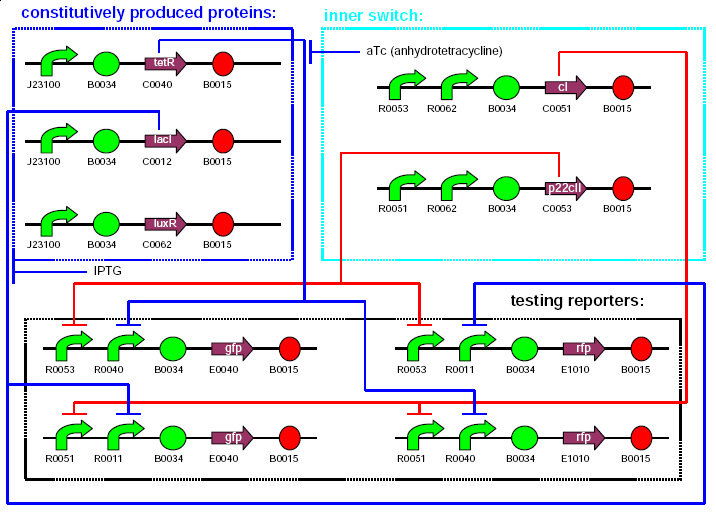ETHZ
From 2007.igem.org

Contents |
Team Members
| [[Image:|thumb|398px|Picture: The ETH Zuerich iGEM Team 2007 (left to right: )]] |
For the International Competition on Genetically Engineered Machines, the teams should be composed of both biologist and engineers. That way, the engineers will try to develop new systems in a bottom-up fashion and run numerical simulations, while the biologists will be able to assess the feasibility of such systems, and construct them from biological parts.
Instructors:
Joerg Stelling
Students:
Martin Brutsche
Katerina Dikaiou
Graduate Students:
Christian Kemmer
Introduction to Synthetic Biology
In order to get an initial understanding of the concepts of synthetic biology, we read and presented publications on various topics. A representative list of the topics that we examined on this “boot-camp”, can be found below, together with their respective presentations.
Choosing the Project
Step 1: Brainstorming
Initially, we wanted to come up with as many ideas as possible, in order to be able to choose among them the best, and find a cool project to carry out. For this reason, we had brainstorming sessions. We split up in three teams, and each team tried to come up with many fancy and showy ideas, which was facilitated by keeping in mind the following brainstorming guidelines:
- Defer judgment - the rules of nature don't apply
- Encourage wild ideas
- Build on the ideas of others
- Be visual
- Go for quantity
- Stay focused on topic
The ideas that we came up with, as were presented in the following meetings, were:
- PID Controller: Design a PID controller out of biological elements. The P component can be a simple
output to a regulatory protein, and the I component can be the overall protein production at a time period. What can the D component be?
- Motion Detector: Cells are grown on a petri dish. Below the dish, moving images are displayed. A 3-
state automaton is proposed. Output A is created when light is present. Output B is created when light is absent. Moving patterns will cause some cells to create both outputs over time. This will result in some “inspector” cells producing output C, by collecting outputs A and B.
- Analog-to-Digital Converter: Compare the level of protein concentration with thresholds, and digitize
the output.
- Neural Network: Create a sort of biological neural network with bacteria. We should address the issue
of learning, and find a way to incorporate the feedback in the cell decision making process. Directed evolution can be a sort of feedback, but we want to avoid this. (This idea was the basis for the “learning project”)
- Central Pattern Generation: Coordinate two oscillators, so that they are in phase. This can be achieved
through diffusion between the different cell types. (This idea was the basis for the “spatial oscillations project”).
- Paramedic Cells: Some cells are able to detect signals coming from other cells, and create food for
them, or create proteins in order to save them and make them function better.
- Cell Batteries: Cells are able to create and store large quantities of ATP, during a “storing process”.
Afterwards, they can detect a signal and give back all the energy they stored, in a short burst, like a capacitor. Other ideas are that the cells can “blow up” and emit large amounts of GFP, based on the ATP that they have accumulated.
- Flashing Bacteria: Cells are grown on a light pattern. The cells that are on the bright parts of the
image are oscillating in phase, while the others are remaining dark. This results in the observation of a flashing pattern.
- Biocam: Visible to Fluorescent light converter.
- BioCD: “Print” cells on a film, then read them out and “reconstruct” the original data. Basically, it is
an analog to digital converter, followed by a system that can interpret the digitized data. (This idea was the basis for the “Music of life project”, where cells would produce fluorescent proteins based on an analog input. Then, the amount and type of fluorescence would code some music).
- Clock: A follow-the-leader system. We have to groups of cells. The first group creates something that
repels the second group. The second group creates a protein that attracts the first group. This way, they first group wants to “catch” the second group, whereas the second group wants to “avoid” the first group. This results in them moving around. We can say that the second group is the leader, and the first group exhibits a “follow-the-leader” behavior.
- Sensors: Various systems that can sense PH, pressure, temperature, meat quality, moisture e.t.c have
been proposed.
The Project
Our goal is to design an E.coli strain, able to distinguish between two chemical substances after an assigned learning process, induced by an external chemical signal. After the bacterial strain was taken to a testing phase, the output will result in either yellow or cyan fluorescence, depending on whether the bacteria recognized the same chemical substance in the testing phase as it was trained in the learning phase or a different one. We aim to implement our system using a toggle switch consisting of different repressor and activator proteins coupled with double regulatory regions.
System Models
Lab Work
Cloning Plan
Lab Notes
Week 1 06.08.07 - 12.08.07
detailed lab notes
Week 2 13.08.07 - 19.08.07
detailed lab notes
Week 3 20.08.07 - 26.08.07
detailed lab notes
Week 4 27.08.07 - 02.09.07
detailed lab notes

